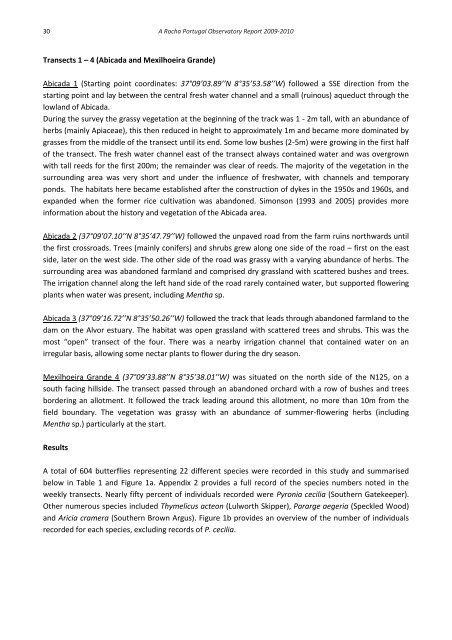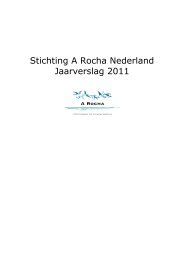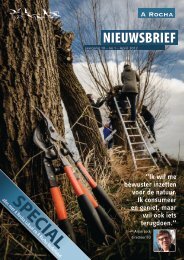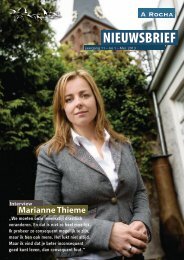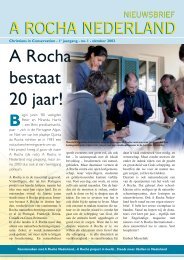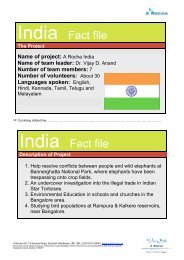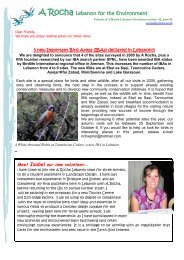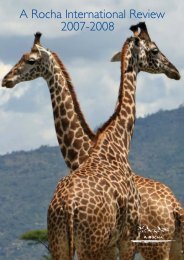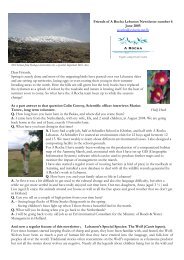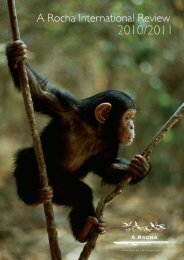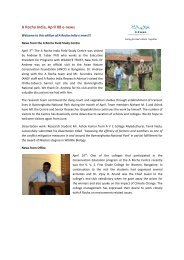A Rocha Portugal Observatory Report 2009-2010
A Rocha Portugal Observatory Report 2009-2010
A Rocha Portugal Observatory Report 2009-2010
Create successful ePaper yourself
Turn your PDF publications into a flip-book with our unique Google optimized e-Paper software.
30 A <strong>Rocha</strong> <strong>Portugal</strong> <strong>Observatory</strong> <strong>Report</strong> <strong>2009</strong>-<strong>2010</strong><br />
Transects 1 – 4 (Abicada and Mexilhoeira Grande)<br />
Abicada 1 (Starting point coordinates: 37°09’03.89’’N 8°35’53.58’’W) followed a SSE direction from the<br />
starting point and lay between the central fresh water channel and a small (ruinous) aqueduct through the<br />
lowland of Abicada.<br />
During the survey the grassy vegetation at the beginning of the track was 1 - 2m tall, with an abundance of<br />
herbs (mainly Apiaceae), this then reduced in height to approximately 1m and became more dominated by<br />
grasses from the middle of the transect until its end. Some low bushes (2-5m) were growing in the first half<br />
of the transect. The fresh water channel east of the transect always contained water and was overgrown<br />
with tall reeds for the first 200m; the remainder was clear of reeds. The majority of the vegetation in the<br />
surrounding area was very short and under the influence of freshwater, with channels and temporary<br />
ponds. The habitats here became established after the construction of dykes in the 1950s and 1960s, and<br />
expanded when the former rice cultivation was abandoned. Simonson (1993 and 2005) provides more<br />
information about the history and vegetation of the Abicada area.<br />
Abicada 2 (37°09’07.10’’N 8°35’47.79’’W) followed the unpaved road from the farm ruins northwards until<br />
the first crossroads. Trees (mainly conifers) and shrubs grew along one side of the road – first on the east<br />
side, later on the west side. The other side of the road was grassy with a varying abundance of herbs. The<br />
surrounding area was abandoned farmland and comprised dry grassland with scattered bushes and trees.<br />
The irrigation channel along the left hand side of the road rarely contained water, but supported flowering<br />
plants when water was present, including Mentha sp.<br />
Abicada 3 (37°09’16.72’’N 8°35’50.26’’W) followed the track that leads through abandoned farmland to the<br />
dam on the Alvor estuary. The habitat was open grassland with scattered trees and shrubs. This was the<br />
most “open” transect of the four. There was a nearby irrigation channel that contained water on an<br />
irregular basis, allowing some nectar plants to flower during the dry season.<br />
Mexilhoeira Grande 4 (37°09’33.88’’N 8°35’38.01’’W) was situated on the north side of the N125, on a<br />
south facing hillside. The transect passed through an abandoned orchard with a row of bushes and trees<br />
bordering an allotment. It followed the track leading around this allotment, no more than 10m from the<br />
field boundary. The vegetation was grassy with an abundance of summer-flowering herbs (including<br />
Mentha sp.) particularly at the start.<br />
Results<br />
A total of 604 butterflies representing 22 different species were recorded in this study and summarised<br />
below in Table 1 and Figure 1a. Appendix 2 provides a full record of the species numbers noted in the<br />
weekly transects. Nearly fifty percent of individuals recorded were Pyronia cecilia (Southern Gatekeeper).<br />
Other numerous species included Thymelicus acteon (Lulworth Skipper), Pararge aegeria (Speckled Wood)<br />
and Aricia cramera (Southern Brown Argus). Figure 1b provides an overview of the number of individuals<br />
recorded for each species, excluding records of P. cecilia.


